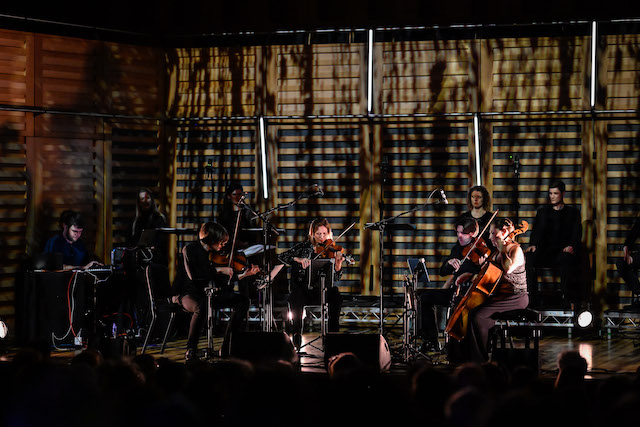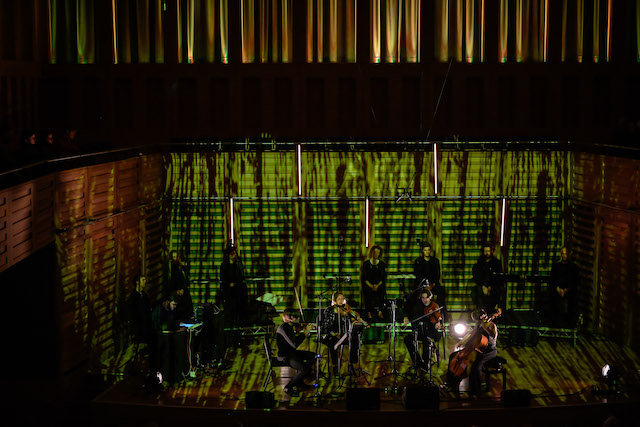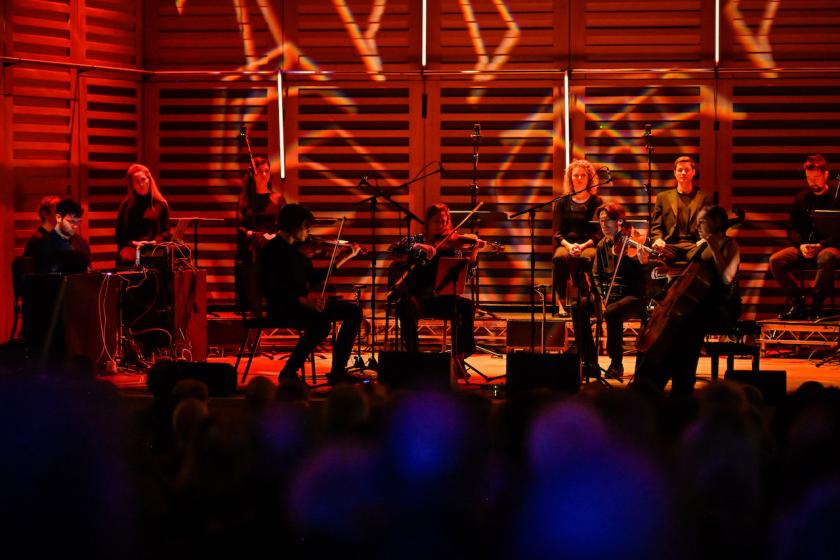What better way to start a season about the Earth than by looking back on it from an astronaut’s perspective? At a time when the activities of assorted billionaires and emerging superpowers are making the space race topical again, it feels more than appropriate for Kings Place to begin its Earth Unwrapped programme with Terry Riley’s Sun Rings.
As one of the deities of minimalism and experimental music, Riley was an obvious choice when NASA was looking for a composer to celebrate 25 years since the launch of the Voyager space programme. His ten-part composition – liberally punctuated with high-pitched bleeps, static crackles and cosmic squawks from space – premiered in 2002 with his long-term collaborators, the Kronos Quartet. Now, in his 90th year – which is also being celebrated at Kings Place – he provided the launch pad for a programme that will include nature beatboxing, an anarchic interpretation of Vivaldi’s Four Seasons and ice music. In place of the Kronos, the bracingly intelligent Sacconi Quartet took on the challenge of whirling us into the stratosphere.
The evening began in darkness as we were enveloped in sounds from space recorded by Don Gurnett, the research scientist at Iowa City who pioneered the plasma-wave equipment installed on the Voyager probes to record electrons hurtling across the universe. Gurnett gave these recordings to Riley under headings that – quite wonderfully – included “auroral hiss”, “electron plasma oscillation” and “electron cyclotron harmonic emissions”. Against this cosmic sonic backdrop – in an innovation for this performance – Terry Riley’s voice explained how the composition had come about when NASA had approached him. After this overture the lights went up on the musicians and we achieved lift-off.
It requires fierce rigour as well as talent to pull this off – as Riley himself commented in his interview, the NASA recordings which, to be frank, sound like extra-terrestrial indigestion, can come across as something of a “cosmic joke”. As well as performing their instruments the musicians need to activate electronic signals by moving their hands over sensors. Get it wrong and it could look both dated and embarrassing, yet the Sacconi Quartet were every bit as meticulous in their execution of this more free form aspect of the composition as they were in performing the notes from the score. As a result it was not hard to get caught up in music that felt as if it was simultaneously expanding the frontiers of space and the mind. The second movement – "Hero Danger" – began with meditative drumming which was gradually heightened by ambient Asian-influenced melodies from the quartet that lulled us into a sense of hypnotic calm. Then we were jolted awake again by the spiky syncopations of the third movement, "Beebopterismo", delivered with a sense of electricity and drama. In an earth context, the soothing melodies of Planet Elf Sindoori could almost have been described as pastoral – here they represented a deliciously distorted oasis of calm. Violinist Hannah Dawson in particular stood out as she alternated passages of rich lyricism with a more biting rhythmic delivery.
The second movement – "Hero Danger" – began with meditative drumming which was gradually heightened by ambient Asian-influenced melodies from the quartet that lulled us into a sense of hypnotic calm. Then we were jolted awake again by the spiky syncopations of the third movement, "Beebopterismo", delivered with a sense of electricity and drama. In an earth context, the soothing melodies of Planet Elf Sindoori could almost have been described as pastoral – here they represented a deliciously distorted oasis of calm. Violinist Hannah Dawson in particular stood out as she alternated passages of rich lyricism with a more biting rhythmic delivery.
As a critic, it’s always interesting to see how your experience of one concert is impacted by what you’ve reviewed just before it. For this writer it was astonishing to observe how much similarity there was between Riley’s Sun Rings and the conceptual framework underlying Mahler’s Third Symphony – which I reviewed when it was conducted by Gustavo Dudamel at the Barbican the night before. There is no literature I can find that demonstrates that Riley was influenced by Mahler on any level. Yet both pieces of music attempt to encapsulate the composer’s idea of the cosmos, both use choirs in the latter movements, and both end on a message of love.
It was in the fifth movement, "Earth Whistler"s, that the choir members of Festival Voices – conducted by Gregory Batsleer (also visionary director of the London Handel Festival) – started to make their presence felt. Three sopranos, accompanied by detached arpeggios from the viola, sang a liturgical-style chorus that amplified the spiritual sense of this voyage into the unknown. In "Earth/Jupiter Kiss" – which began with eery glissandos – we found ourselves back in a more abstract sonic landscape, where the subatomic “whistlers” in space sounded almost like birds in a tropical jungle. "The Electron Cyclotron Frequency Parlour" took us into a more frenetic space, with aggressively repeated notes that interacted with Brett Cox’s electronic soundscape to take us further out of our comfort zone. What was so stimulating about this performance was that every time you felt that the musical ideas had been pushed to their limits, you were suddenly surprised with something completely different. In "Prayer Rings" the whole choir came together to deliver a resonantly beautiful message of peace and forgiveness. Then in "Venus Upstream" a continual beeping made it feel as if we were in some kind of extra-terrestrial emergency room as the strings fed into the mood of agitation. The final movement, "One Earth, One People, One Love" – which included the voices of writer Alice Walker and astronaut Gene Cernan against a meditative beat – invited us to reflect on our place in space, reality and existence, a thought process heightened by Cara Berridge’s gorgeous, profound accompaniment on the cello.
What was so stimulating about this performance was that every time you felt that the musical ideas had been pushed to their limits, you were suddenly surprised with something completely different. In "Prayer Rings" the whole choir came together to deliver a resonantly beautiful message of peace and forgiveness. Then in "Venus Upstream" a continual beeping made it feel as if we were in some kind of extra-terrestrial emergency room as the strings fed into the mood of agitation. The final movement, "One Earth, One People, One Love" – which included the voices of writer Alice Walker and astronaut Gene Cernan against a meditative beat – invited us to reflect on our place in space, reality and existence, a thought process heightened by Cara Berridge’s gorgeous, profound accompaniment on the cello.
This is the first season presided over by new artistic director Sam McShane, and it bodes well for the expanding of audience horizons in ways that are as fruitful as they are intelligent. It’s a testament to all the musicians involved that it felt as relevant now as it must have done to audiences who heard it almost quarter of a century ago.














Add comment